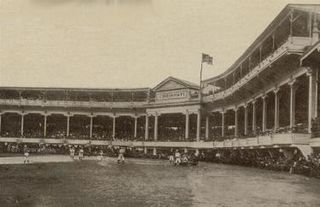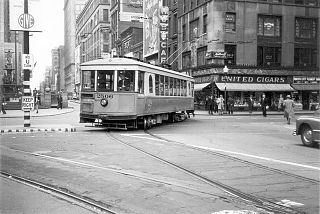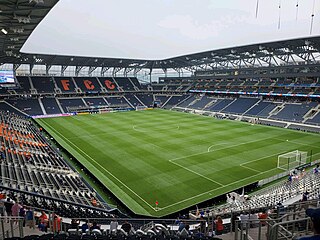Related Research Articles

Palace of the Fans was a Major League baseball park located in Cincinnati, Ohio. It was the home of the Cincinnati Reds from 1902 through 1911. The ballpark was on an asymmetrical block bounded by Findlay Street (south), Western Avenue, York Street (north) and McLean Avenue (west).
The Bank Street Grounds was a baseball park located in Cincinnati. The park was home to three major league baseball teams. The National League Cincinnati Stars club in 1880, the current Cincinnati Reds franchise from 1882 to 1883 and the Cincinnati Outlaw Reds of the Union Association in 1884. It succeeded the Avenue Grounds as the home site for professional ball in the Queen City.

The Cincinnati Subway was a partially completed rapid transit system beneath the streets of Cincinnati, Ohio. Although the system only grew to a little more than 2 miles (3.2 km) in length, its derelict tunnels and stations make up the largest abandoned subway tunnel system in the United States. Construction began in the early 1900s as an upgrade to the Cincinnati streetcar system, but was abandoned due to escalating costs, the collapse of funding amidst political bickering, and the Great Depression during the 1920s and 1930s.

Over-the-Rhine, often abbreviated as OTR, is a residential neighborhood located in the urban basin of Cincinnati, Ohio. Over-the-Rhine is among the largest, most intact urban historic districts in the United States. Originally settled by German immigrants, the neighborhood became home to significant African-American and Appalachian populations during the mid-20th century. It is home to several of Cincinnati's most famous landmarks, including Music Hall and Findlay Market.

The Tyler Davidson Fountain or The Genius of Water is a statue and fountain located in Cincinnati, Ohio. It is regarded as the city's symbol and one of the area's most-visited attractions. It was dedicated in 1871 and is the centerpiece of Fountain Square, a hardscape plaza at the corner of 5th and Vine Streets in the downtown area. It is surrounded by stores, hotels, restaurants and offices. Originally, and for more than 130 years, it was located in the center of 5th Street, immediately west of Walnut Street. In 2006, renovations were undertaken to Fountain Square and the Tyler Davidson Fountain was temporarily removed. When reinstalled it was relocated to a much wider space near the north end of the reconfigured square, closer to the Fifth Third Bank Building and away from street traffic. The fountain is turned off for the winter months and turned on again in time for the first home game of Major League Baseball's Cincinnati Reds.

Findlay Market in historic Over-the-Rhine, Cincinnati, Ohio, is the state's oldest continuously operated public market. The Findlay Market Building was listed on the National Register of Historic Places (NRHP) on June 5, 1972. The market is the last remaining of the nine that once served Cincinnati. In 2019 Newsweek named it one of the top ten public markets in the world.

James Findlay was an American merchant, politician and veteran of the War of 1812, having served with both the state militia and the United States Army. He was based in Cincinnati, Ohio after migrating there as a young man. He was elected as mayor of Cincinnati to two non-successive terms.
League Park was a Major League baseball park located in Cincinnati, Ohio, United States. It was the home of the Cincinnati Reds from 1884 through 1901. The ballpark was on an asymmetrical block bounded by Findlay Street (south), Western Avenue, York Street (north) and McLean Avenue (west).
This is relating to the culture of Cincinnati, Ohio.

St. Francis Xavier Church is a Catholic parish located at 611 Sycamore Street, Cincinnati, Ohio. This was the location of the first diocesan cathedral and the center of early Catholic life in the city. It was dedicated to St. Peter on December 17, 1826.

Washington Park is bounded by West 12th, Race and Elm Streets in the Over-the-Rhine neighborhood of Cincinnati, Ohio, United States. The park is owned and operated by the Cincinnati Park Board. The 6-acre (2.4 ha) park served as Presbyterian and Episcopal cemeteries before it was acquired by the city from 1858 to 1863.

St. Rose Church, also known as St. Rosa Church, is a Roman Catholic church located in Cincinnati, Ohio's East End neighborhood at 2501 Riverside Drive. Located near the banks of the Ohio River, the church has endured many floods as evidenced by a high water mark painted on the rear side.
WBVI is a commercially licensed radio station, broadcasting from Fostoria, Ohio, United States, but is marketed as a Findlay radio station. WBVI is owned and operated by the Roppe Corporation, but does business as TCB Holdings, Inc. It airs a Classic hits music format.

Queensgate is one of the 52 neighborhoods of Cincinnati, Ohio. It sits in the valley of Downtown Cincinnati and is dominated by industrial and commercial warehouses. Cincinnati's nickname of "Porkopolis" started here with hog slaughtering in the early 19th century.

Piatt Park is the oldest park in Cincinnati, Ohio. The urban park stretches two blocks between Elm Street and Vine Street on Garfield Place/8th Street. The park is owned and maintained by the Cincinnati Park Board.
The history of Over-the-Rhine is almost as deep as the history of Cincinnati. Over-the-Rhine's built environment has undergone many cultural and demographic changes. The toponym "Over-the-Rhine" is a reference to the Miami and Erie Canal as the Rhine of Ohio. An early reference to the canal as "the Rhine" appears in the 1853 book White, Red, Black, in which traveler Ferenc Pulszky wrote, "The Germans live all together across the Miami Canal, which is, therefore, here jocosely called the 'Rhine'." In 1875 writer Daniel J. Kenny referred to the area exclusively as "Over the Rhine". He noted, "Germans and Americans alike love to call the district 'Over the Rhine'."

Streetcars operated by the Cincinnati Street Railway were the main form of public transportation in Cincinnati, Ohio, at the end of the 19th century and the start of the 20th century. The first electric streetcars began operation in 1889, and at its maximum, the streetcar system had 222 miles (357 km) of track and carried more than 100 million passengers per year. A very unusual feature of the system was that cars on some of its routes traveled via inclined railways to serve areas on hills near downtown. With the advent of inexpensive automobiles and improved roads, transit ridership declined in the 20th century and the streetcar system closed in 1951. Construction of a new streetcar system, now known as the Connector, began in 2012. Consisting initially of a single route, the new system opened on September 9, 2016.

The Steps of Cincinnati refers to roughly 400 sets of city-owned steps in Cincinnati, Ohio, in the United States. The steps are an unusual and integral mode of transportation in the city. In addition to practical use, the steps offer recreational users exercise and serve as a scenic attraction to tourists.

TQL Stadium is a soccer-specific stadium in Cincinnati, Ohio, United States. It is the home of FC Cincinnati, a Major League Soccer (MLS) team that has played there since the stadium opened on May 16, 2021. The stadium holds approximately 26,000 spectators and is located in the West End neighborhood, at the former site of Stargel Stadium on Central Parkway at Wade Street. It has a Bermuda Grass surface called Tahoma 31. During construction, it was also known as the West End Stadium.
References
- ↑ Federal Writers' Project (1943). Cincinnati, a Guide to the Queen City and Its Neighbors. Best Books on. p. 145. ISBN 9781623760519.
- ↑ Stradling, David (Oct 1, 2003). Cincinnati: From River City to Highway Metropolis. Arcadia Publishing. p. 48. ISBN 9780738524405.
- ↑ Crocker, Mary Beth (Oct 2003). Findlay Market's Bounty. p. 34.
{{cite book}}:|work=ignored (help)